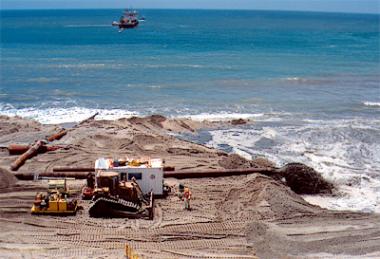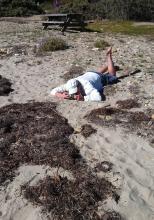Why Will Sea Level Rise Affect Beach Critters?
A wide beach is necessary for the survival of many beach animals. For example, sand crabs move up and down the beach with the tide, following the water conditions they prefer. These highly mobile animals use more than 60% of the entire beach width over the course of a year and retreat to the upper beach to escape extreme events like storms. As sandy shorelines retreat inland with sea level rise, beach critters will need to move further inland as well. Unfortunately, retreat is not possible on most Southern California beaches since coastal development or armoring prevents the beach from migrating inland. Many species likely will be forced to remain too close to the water for comfort, potentially leading to local extinctions.
Which Part of the Beach Is Especially Vulnerable To Sea Level Rise?

If sea level rise occurs where the beach has no space to naturally migrate inland, the upper beach will likely disappear first. By 2100, given the amount of predicted sea level rise, less than 10% of the Southern California coast will have the potential to provide suitable upper beach habitat.
Many creatures that live in the upper beach have very specific needs, making them less adaptable to the changes that occur with sea level rise, coastal development, and other human impacts. By looking at historical data, researchers found many creatures that live in the upper beach, including the isopods (or roly polies), Tylos punctatus and Alloniscus perconvexus, have indeed disappeared from many beaches in Southern California. The remaining populations only exist in remote, ungroomed, and undeveloped beaches.
To conserve these beach critters, open space behind beaches must be protected to allow them to migrate inland over time. Managers should note that roly polies and upper beach plants are not only indicators of the health of the upper beach habitat but also of the beach in its entirety. Read more in Best Practices.
How will our responses to sea level rise affect beach ecology?
Seawalls
Many coastal communities respond to the threat of sea level rise by building seawalls. However, it is widely known that seawalls often accelerate erosion. Waves reflected by seawalls scour the beach in front or nearby, ultimately increasing erosion and causing beaches to narrow.
A study in 2008 showed that when seawalls cause beaches to narrow, the dry upper part of the beach is lost first. The reduced habitat diversity results in fewer types of sand-dwelling creatures.
Shorebirds that prey upon these sand-dwelling creatures and use the sandy upper beach habitat also decline in abundance and diversity. This ecological ripple effect demonstrates how seawalls may have far-reaching consequences for the sandy beach ecosystem.
Beach Nourishment

The practice of placing extra sand on beaches, also known as beach nourishment, is another method used to combat coastal erosion. Like armoring, this practice has certain ecological effects on the sandy beach ecosystem.
A 2006 study found that bulldozers and other construction equipment used to truck in sand can disturb shorebirds and maybe even cause them to abandon their nests. Also, the extra sand is often cemented together into a stiffer mixture, which prevents wind from blowing it into sand dunes, slowing the formation of dune habitat.
The new sand may not be the same grain size or chemical makeup of the natural sand, changing the habitat that beach critters rely upon. As the ocean starts eroding the introduced sand, the water offshore can become muddy, potentially smothering marine life and changing coastal water quality. Critters that rely on relatively clean, clear water, like clams, can die off in large numbers.
Finally, organisms can be buried and killed when the extra sand is initially delivered to the beach.
Despite these many impacts, researchers acknowledge that beach nourishment is preferable to seawalls and hard armoring because it causes less ecological harm. Credit: SANDAG
From the Experts

David Hubbard
President
Coastal Restoration Consultants, Inc.
"The most important thing to understand is that beaches are very dynamic and that they need room to move. When storms come in or sea level rises, beaches move inland. After disturbances end, beaches recover. If there are barriers to beach movement, then the process breaks down and beaches start to lose zones or species starting with the upper beach.”


